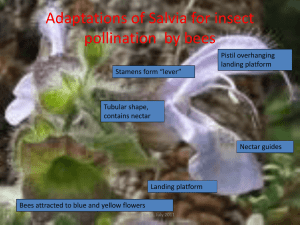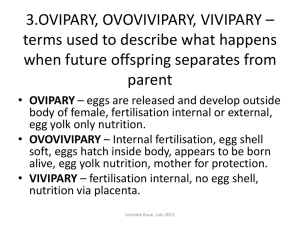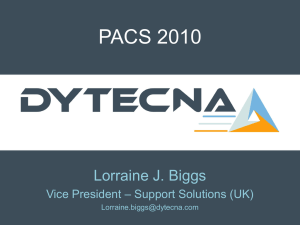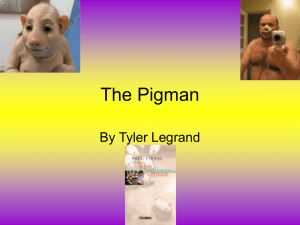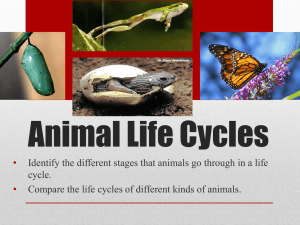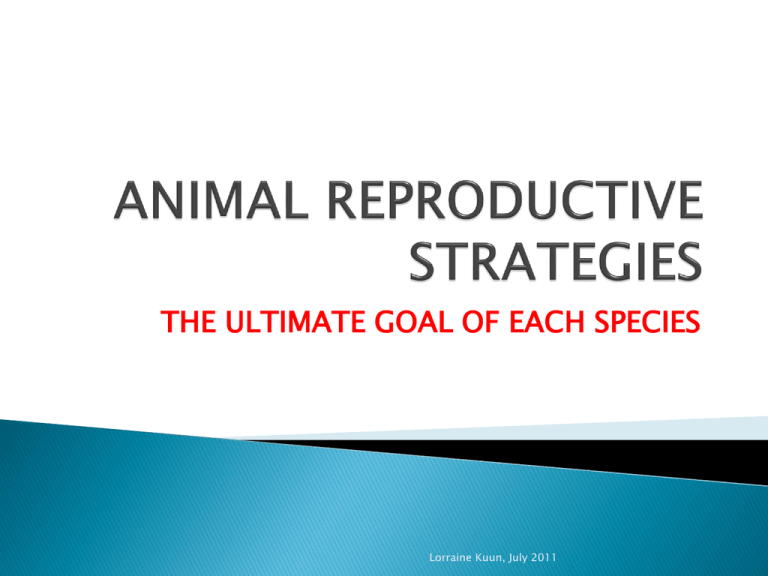
THE ULTIMATE GOAL OF EACH SPECIES
Lorraine Kuun, July 2011
To produce the maximum number of
surviving offspring ...
while using the least amount of energy.
This is called the
reproductive effort.
Lorraine Kuun, July 2011
1.
2.
3.
4.
5.
External vs Internal fertilisation
Ovipary, ovovivipary and vivipary
Precocial and Altricial
development
Amniotic egg
Parental care
Lorraine Kuun, July 2011
Disadvantages
of external
fertilisation (outside the body):
1. Wasteful; huge loss of energy –
many eggs produced, few
survive.
2. Fertilisation not certain.
3. Environmental conditions
important for hatching of eggs
Lorraine Kuun, July 2011
Lorraine Kuun, July 2011
Mating occurs, but no copulation
Lorraine Kuun, July 2011
Occurs in insects and terrestrial vertebrates
i.e. birds, reptiles and mammals.
Marine mammals and some fish e.g. sharks
and rays also have internal fertilisation.
Mating and copulation occurs.
Male insects and mammals have a penis –
organ to transfer sperm to body of female.
Fluid inside female provide medium for
sperm to swim towards egg cell(s).
Lorraine Kuun, July 2011
OVIPARY – eggs are released and develop outside
body of female, fertilisation internal or external,
egg yolk only nutrition.
OVOVIVIPARY – Internal fertilisation, egg shell
soft, eggs hatch inside body, appears to be born
alive, egg yolk nutrition, mother for protection.
VIVIPARY – fertilisation internal, no egg shell,
nutrition via placenta.
Lorraine Kuun, July 2011
Most
fish, amphibians and lower
aquatic forms.
Needs large numbers of eggs.
Lorraine Kuun, July 2011
Shark egg pouch with yolk clearly visible
Lorraine Kuun, July 2011
1.
2.
3.
4.
5.
Fewer eggs needed – higher survival rate of
offspring.
Developing embryo much less vulnerable to
predators.
Developing embryo not subject to
environmental changes e.g. temperature.
Young born fully developed, can feed and
escape predators more easily.
Occurs in some invertebrates, fish and
reptiles.
Lorraine Kuun, July 2011
Young puff adder being “born alive”
after hatching inside mother; note position of cloaca.
Lorraine Kuun, July 2011
Occurs in placental mammals, some sharks
and scorpions
Fertilisation internal, no shell
Placenta responsible for nutrition – young
born alive
1. fewer eggs necessary
2. energy available for nourishment and
protection of embryo, as well as parental care
Lorraine Kuun, July 2011
Lorraine Kuun, July 2011
PRECOCIAL
ALTRICIAL
1. Young hatch or born 1. Born or hatched
when almost fully
when not welldeveloped
developed
2. Open eyes, hair or
2. Often naked, lacking
down
hair or down
3. Active or mobile
3. Cannot walk or fly
4. Not confined to
4. Confined to nest or
nests
burrow
5. Energy goes into
5. Energy goes into
prenatal
parental care after
development
birth
Lorraine Kuun, July 2011
Ground-nesting birds e.g. Penguins,
domestic poultry, ostriches
Large mammals e.g. Elephants, species of
antelope, horses etc
Allows young to fend for itself, feed and stay
warm
Stay with herd for protection against
predators
Learn from older individuals in herds
OFFSPRING HAS GOOD CHANCE OF SURVIVAL
Lorraine Kuun, July 2011
Left: Penguin chick and
Above: foal, both mobile
soon after birth
Lorraine Kuun, July 2011
Altricial bird – see mouth-lining that attracts mother
Lorraine Kuun, July 2011
Mice survive in broods,
cared for by mother (left);
Kittens born weak and totally
dependent on mother (below)
Lorraine Kuun, July 2011
Adaptation of later vertebrates; can lay eggs
in terrestrial environment.
Amniotic egg has fluid-filled, extraembryonic membranes that prevents embryo
from drying out.
Earlier vertebrates lay eggs in water; need to
return to water/live in water to reproduce.
Amniotic egg lessens dependence on water
for reproduction.
Lorraine Kuun, July 2011
Fertilisation is internal.
Extra-embryonic (not part of embryo)
membranes only develop after fertilisation.
Membranes are:
1. Amnion
2. Allantois
3. Yolk sac
4. Chorion
Major evolutionary development; allowed first
reptiles to colonise land!
Lorraine Kuun, July 2011
Lorraine Kuun, July 2011
The fluid-filled amnion surrounds and protects
the embryo, especially against dehydration and
shock.
Allantois acts as reservoir for nitrogenous waste
in birds and reptiles.
Yolk sac holds nutritious food for development of
embryo.
Chorion surrounds all other membranes: in birds
it allows for gaseous exchange; in mammals it
forms the placenta (taking over functions of
allantois and yolk sac, amongst others (see
human reproduction).
Lorraine Kuun, July 2011
Any pattern of behaviour in which parent
spends time or energy to improve the
1survival, 2condition and 3future reproductive
success of offspring.
Care can be given at any stage:
1. Prenatal – guarding eggs, building nests,
carrying broods, incubating eggs and
placental nourishing.
2. Post-natal – providing food, protecting
offspring, teaching offspring.
Lorraine Kuun, July 2011
Little or no parental care means a low
reproductive effort.
Reproductive energy put into producing
masses of eggs.
High mortality rate amongst eggs as well as
young.
Few individuals survive to reproductive age.
E.g. Most fish, amphibians, insects, most
reptiles
Lorraine Kuun, July 2011
Few eggs or young produced.
Low mortality rate amongst eggs or young.
High reproductive effort.
Reproductive energy goes into parental care
after birth (post-natal).
Most offspring survive to reproductive age.
E.g. Mammals, birds, some reptiles,
exceptions amongst fish and Arthropods.
Lorraine Kuun, July 2011

